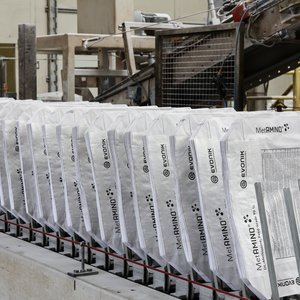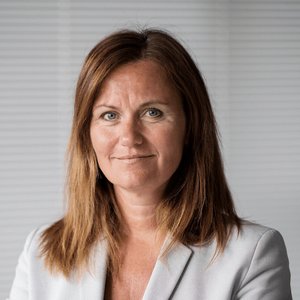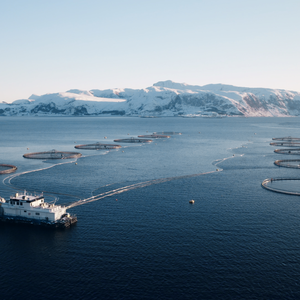By Suzi Fraser Dominy
Tucked away in the industrial park of a small Belgian village, a cutting edge aquafeed facility quietly came on-line in mid-September and is set to revolutionize the larval feed sector. The name, Bern Aqua, may not be on the tip of your tongue – yet. But chances are, if you run a hatchery, you know their feeds; without fanfare or hype, word has spread about the products of this small, privately owned company that has already captured a surprisingly large share of the larval feed market.
Bern Aqua has grown out of Tesgofarm Aqua, a larval feed company formed in 1998 by Bernard Devresse, an aquafeed researcher with a solid background in practical feed processing and nutrition - and a mission to make outstanding, science-based feeds.
“It’s amazing”, Devresse told Aquafeed.com, “aquaculture feed processing technology and nutrition research has come such a long way in recent years, yet little of this new understanding has been translated into products that can help hatcheries have healthier stock, better grow-out rates – in other words, greater profitability. In fact even new products are generally using the same old formulations and the same old processing technology. We know better and we can do better: we have a built a portfolio of products based on 21st century science for the modern farmer”.
| Fluid bed dryer and Marumerizer: cutting-edge technology used to make BernaAqua feeds | |
Feeds of the future
Bern Aqua has developed a full line of fish and shrimp larval feeds: rotifer and Artemia enrichment products; direct shrimp larvae enrichment products and grow-out feeds. Some are new versions of Tesgofarm products while others are completely new. What sets them apart is their use of high quality raw materials and ingredients – such as fresh fish, rather than fishmeal, composition and physical quality close, and in many ways better than, the animal’s natural food, and the application of new generation processing technology, such as micro-encapsulation, agglomeration, marumerization and cold extrusion.
“The two major factors that are key to larval feed quality are leaching and digestibility”, Devresse explained. “We control leaching by encapsulating micro-particles of less than 300 µm and by coating particles larger than 300 µm. Digestibility we control through the use of “native” proteins and the inclusion of hydrolyzed proteins (peptides and FAA) – and by reducing protein denaturation,”
“Traditionally, larval feeds that are described as micro-particulate, are produced by extrusion cooking. Although they are generally about the right size, and start off nutritionally well balanced, extrusion denatures protein by heat and mechanical energy, and produces crumbles that are highly porous, and therefore leach badly. Leaching can be very fast, with only the poorly digestible, insoluble protein remaining in the particle after just a few minutes,” he said.
“The other methods used by industry are pelleting or flaking, which also denatures protein by heat and produces crumbles that are porous and unstable in water”.
Agglomeration, a method whereby particles are created by coalescing micro-particles - also known in the pharmaceutical industry where it evolved, as ‘wet granulation’, is the only technology that can produce water stable particles, doesn’t denature the feed by heat and allows micro-capsule technology to be used without damaging the capsules, Devresse claims. “It’s a constructive process – not destructive like crumbling and the only technology that preserves feed integrity - both digestibility and capsule integrity”. “It is the technology of the future in larval feed production and will replace crumbling”, he predicts, adding “We have been using it since 1998”.
The concept behind Bern Aqua feeds is the development of fish and shrimp foods based on nature. “We look at the natural food that these animals eat – its composition and physical properties and how they eat it - and we make our feeds as close to that as we can – but just a little better,” Devresse says, adding that all ingredients are natural too.
Built on partnerships
Tesgofarm Aqua morphed into Bern Aqua a year ago and Devresse has used the time to develop and consolidate not just scientifically advanced new feeds but the partnerships that are key to the strength of the manufacturing, R&D and sales clout that he has leveraged from his small core business.
“We could not possibly develop our strongly science-based products in-house without investing millions in lab equipment, and that would make the development costs unsustainable - so we have drawn on some of the world’s best research minds and facilities” Devresse said. Research partners include: DVK (Melle, Belgium); FFW - RUG, University of Ghent (Belgium); TNO (the Netherlands); Ifremer - INRA (France); Prof. Lightner, University of Arizona, pathology lab (USA), etc.– not to mention several analytical labs.
By the same reasoning, Devresse is also continuing to outsource some of his production, choosing to invest selectively in his new manufacturing facility. As from the early days of Tesgofarm Aqua, Joosen Luyckx Aquabio, a feed manufacturer, flour miller and sturgeon farming enterprise, will take care of the cold extrusion, while encapsulation is still to be handled by Dr. Jurgen Eulenstein GmbH, a firm with years of specialist pharmaceutical know-how and one of the world’s largest micro-encapsulation companies operating in aquaculture. The scale of the operation means that a Bern Aqua run of 24 tonnes of liquid capsules can be made in 4 hours, under full temperature control, dried, PCB and salmonella tested and delivered to Bern Aqua ready for agglomeration within days. “Freshness is everything”, Devresse explained. “We are using fresh marine proteins from fish, squid etc., frozen on the boat, right from the ocean, as well as peptides, free amino acids, refined stabilized fish oils, lecithins and phospholipids along with high levels of nutraceuticals (nucleotides, Vitamin C, Vitamin E, astaxanthin, trace minerals such as seleno-methionine and chromium picolinate – this huge specialized production line ensures total freshness of our complex and delicate product – and room for expansion too!”
The new manufacturing facilities
Bern Aqua’s own new facilities consist of fully automated lines for milling, agglomeration, marumerization, liquid feeds and packaging. Ward Brijs, who joined the team in April, found himself on the look out for a suitable building in June and by July taking receipt of the key equipment. By September, the plant was ready for its official opening and well on the way towards GMP+ accreditation, the stringent Dutch Good Manufacturing Practice (GMP) + Hazard Analysis and Critical Control Point (HACCP) quality certification standard for the feed industry, used throughout Europe and internationally.
Steady growth
Based on a track record of consistent annual growth of between 30% and 50%, Devresse confidently predicts that the company will achieve sales of €10 million/year within the next few years. Bern Aqua has won a loyal following in those countries where it has focused its marketing activities, claiming a 38% share of the European larval feed market: (51% in Greece, 16% in Spain, 32% in Turkey); 68% of the market in India - 18% of the Indonesian total larval feed market and 11.7% of the Latin American market.
Bern Aqua has ambitious plans to become a global presence in aquafeed – and in particular to substantially raise its presence in the Asian and Latin American markets, as it continues to build its network of agents and distributors.
Future focus
In the meantime, Devresse is concentrating on the further development of innovative products and taking care of his customers. “We are totally customer-centred”, Devresse says. “We want to do more than just sell them feed: from small things, like our website where our customers will soon be able to log on, enter their product batch number and pull up the certificate for their product – to the major things such as helping solve problems such as fish larvae deformities”.
With this in mind, two well known consultants have recently joined forces with Bern Aqua to provide consulting services to Bern Aqua’s customers: European hatchery consultant and former Ifremer-INRA researcher and a pioneer in aquaculture Guirec Dewavrin, and a L. vannamei expert and hachery manager, well known in Central America. Their role will be to help Bern Aqua’s customer to improve husbandry and rearing techniques in their hatcheries.
The creative energies of Bernard Devresse show no signs of weakening when it comes to product development either. He is already talking about feeds for new species such as cod and halibut and replacing live feed entirely. And from what I have seen so far, I for one have no doubt that he will succeed.
For more information on Bern Aqua or its products, contact Bernard Devresse at: Bernard@BernAqua.com or local distributors at www.bernaqua.com










